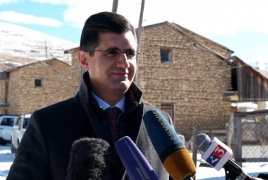Water supply project continues in Armenia's rural communities December 14, 2016 - 17:54 AMT PanARMENIAN.Net - The Foundation for the Preservation of Wildlife and Cultural Assets (FPWC) in cooperation with VivaCell-MTS has built a 2050-meter-long water pipeline in Gnishik community in the framework of the Water Supply Improvement program. As part of the program, dividing joints and water pressure regulators have been installed. As a result, the entire village is provided with constant water supply. The water was available to only 30% of the community for 2 hours every other day in the past, while now the water supply is 24/7. The former water supply system of the community had been in a very bad condition for many years. The dilapidated pipes increased the leakage, while frequent accidents caused unforeseen financial costs. The village budget funds sometimes were not sufficient to eliminate such problems. The residents could be deprived of drinking water for weeks. The project of water supply system in rural communities thus brings 24-hour water supply to the village without increasing its amount. The launching of water supply system was attended by the General Manager of VivaCell-MTS Ralph Yirikian, the Founder of FPWC Ruben Khachatryan, Gnishik community head Ara Levonyan, and the residents of the community. “This is one of those villages where we have tried to solve the existing problems step by step. Last year we installed an outdoor lighting system, this year the problem of potable water has been solved. The development of rural infrastructures has always been the focus of our attention. It is important not only in terms of our commitment as a socially responsible company, but also in terms of investing in the well-being of our compatriots, communities and the country in general. It is inspiring to see that the system of values adopted by VivaCell-MTS serves as an example for other organizations,” said Yirikian. As a result of the cooperation between FPWC and VivaCell-MTS, the streets of the village were provided with a light-emitting diode (LED) system. 37 columns of lighting were installed. The Gnishik community has 72 residents who are mainly engaged in agriculture, cattle-breeding and bee-keeping. The region is especially known for its historical and cultural values, as well as its lush nature. Khachkars of 4th-5th centuries have been found here, alongside chapels, tombs and a number of caves. The locale is home to the Armenian mouflon, registered in the Red Book of Armenia, as well as Bezoar ibex, brown bear, lynx, Caucasus leopards and other species. The number of state universities will be reduced from 23 to 8 by 2030, Minister of Education, Science, Culture and Sport Zhanna Andreasyan has said. From September 21 to November 11, a total of 2,820 Russians registered at a place of residence in Armenia, the police has said. The situation on the contact line between Karabakh and Azerbaijan was relatively stable overnight, the Defense Army says. Defense Minister Suren Papikyan has visited the southern Armenian province of Syunik, the Defense Ministry reported on March 18. Partner news |